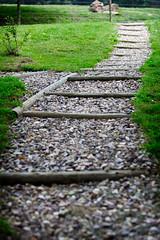“Let us tenderly and kindly cherish, therefore, the means of knowledge. Let us dare to read, think, speak, and write.”
—John Adams
As a cultural historian, and one involved in rethinking graduate education, the notion of pathways is resonant in obvious ways. We are heirs to a tradition of valuing archives that are arranged synchronically and chronologically (classes, curricula (L. to run), and credentials) to effect a set of knowledge outputs and practices—the educated individual, critically forged and capable. That person extends the means and ends. So, John Adams, thanks.
But what happens when those means clot or forestall the impulse to dare and act in language—when the pathways become sclerotic and unnecessarily difficult? I’m thinking, for the moment, of the dissertation as we’ve inherited it from the nineteenth century. It takes the form of a thesis, but really a book, chaptered, indexed, bound. It must be “defended,” in the form of an oral meeting that theoretically works as an opportunity to counter and call bullshit on written material that can cloak error or ambiguity in its formal, officializing guise of print. The defense completes the delivery of new knowledge, by the newly “minted” scholar.
We might view it as a kind of curtain lifting, not unlike the iconic Charles Wilson Peale, in his self-portrait as gatekeeper to the objects of knowledge: “The Artist in His Museum,” 1822.
Since 1822, the museum of scholarly production has advanced through a few more chambers, but the performative and architecture are basically the same. Of late, we then take the text product, make it a codex via arbitrary formatting, and then contract with Proquest to digitize it, make it available on the Internet (not open-access, but close), and then usually provide it to the degree-granting institution’s library to archive. Many humanities students have begun to choose to forego publication at the moment of credentialing, for fear that they might be precluding their pathway not into “knowledge” but into the publication systems that market knowledge—academic presses embedded themselves in a shrinking trade in knowledge commodities.
But that access issue is almost the least of the problems with the PATHWAY of doctoral credentialing. It’s the form itself. That culminating experience is the place where the “running” in curriculum hits obstacles, stalls, crashes, burns, evaporates. Perhaps the digital offers ways to dredge the riverbed and make that knowledge system much more fertile.
I’d like to see dissertations that continue the curriculum—that are, as the MLA and AHA are making preliminary steps toward advocating for, process projects. They would arise out of a richer mix of inputs than an advisor and several other co-advisors to include communities of intra- and inter-institutional faculty and students. They would break down the wall between institutional knowledge and its publics by inviting widespread access to the project as a work in process. Graduate faculties would be configured to critique and follow real-time progress rather than dangerously episodic check-ins. The archive too would not be spatially remote, giving the student little excuse to get “lost.” Indeed, the line between reading and curating would be forever blurred. And indeed the metaphor of “defense” becomes unnecessary, since that need to complement the discrete bounded knowledge-output, the one we must “suspect” of flaws, has always and already been produced through an engagement with multiple voices and assessments.
So rather than Peale in his museum, we’d have the dissertation as collaborative dig, pulling forth, over time. As in:
Also Charles Wilson Peale, this is an image of “The Exhumation of the Mastodon, 1805-08.” Note the temporality Peale foregrounds, the wheel in motion, the dating over a three year period—this is a rendering of process. And it’s a process of manufacturing knowledge collaboratively, over time. It is a lesson from the past about how not to bury things.











